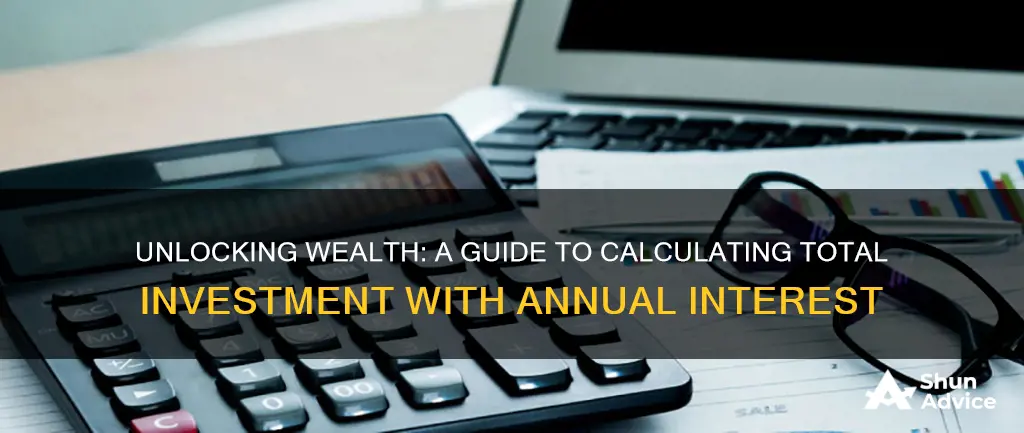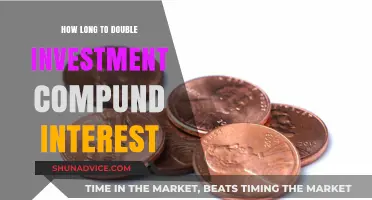
Understanding how to calculate the total investment with annual interest is a crucial skill for anyone looking to grow their money. Whether you're a seasoned investor or just starting, knowing how to calculate the total value of your investments over time can help you make informed financial decisions. In this guide, we'll explore the step-by-step process of calculating the total investment with annual interest, providing you with the tools you need to maximize your financial growth.
What You'll Learn
- Formula for Compound Interest: Calculate total investment with annual interest using the formula: A = P(1 + r)^n
- Interest Rate Impact: Higher interest rates increase total investment growth over time
- Compounding Frequency: Annual compounding is simpler, while more frequent compounding yields higher returns
- Time Period: Longer investment periods lead to larger total amounts due to compound interest
- Initial Investment: The principal amount directly affects the final total investment value

Formula for Compound Interest: Calculate total investment with annual interest using the formula: A = P(1 + r)^n
The formula for compound interest is a powerful tool to calculate the total value of an investment over time, especially when annual interest is involved. This formula is a fundamental concept in finance and is widely used to understand the growth of investments, savings accounts, and loans. Here's a breakdown of how to use this formula to find the total investment with annual interest:
The formula is A = P(1 + r)^n, where:
- A represents the future value of the investment or the total amount accumulated after n years, including interest.
- P is the principal amount, which is the initial amount of money invested or borrowed.
- R is the annual interest rate (in decimal form, e.g., 5% would be 0.05).
- N is the number of years the money is invested or borrowed for.
To calculate the total investment, you need to understand the concept of compound interest. Compound interest means that interest is earned not only on the initial principal but also on the accumulated interest from previous periods. In simpler terms, your investment grows exponentially over time.
Let's break down the formula step by step. First, you add 1 to the annual interest rate (r) to account for the interest earned in the first year. Then, you raise this value to the power of the number of years (n). This calculation represents the growth factor over the investment period. Finally, you multiply this growth factor by the principal amount (P) to find the total amount (A).
For example, if you invest $1000 at an annual interest rate of 5% for 3 years, the calculation would be: A = $1000 * (1 + 0.05)^3. Solving this, you get the future value of your investment, which would be approximately $1157.63. This demonstrates how compound interest can significantly increase your investment over time.
Understanding this formula is essential for financial planning and can help individuals make informed decisions about their money. It allows you to predict the growth of savings, the repayment of loans, or the potential returns on investments, ensuring a more secure and prosperous financial future.
Foreign Investment Trends: Interest Rate Hikes and Capital Flows
You may want to see also

Interest Rate Impact: Higher interest rates increase total investment growth over time
Interest rates play a pivotal role in the world of finance and investment, and understanding their impact is crucial for anyone looking to grow their wealth over time. When interest rates rise, it triggers a chain reaction that can significantly boost total investment growth. Here's a detailed breakdown of this phenomenon:
Understanding the Interest Rate Effect:
Higher interest rates have a direct influence on investment decisions and market behavior. When central banks or financial institutions increase interest rates, it becomes more attractive for individuals and businesses to save and invest. This is because higher interest rates offer a more substantial return on savings, encouraging people to deposit their money in banks or invest in various financial instruments. As a result, the overall pool of funds available for investment grows, providing more capital for businesses and projects.
Impact on Investment Growth:
The impact of higher interest rates on investment growth is twofold. Firstly, it encourages more people to invest, as the potential returns become more appealing. This increased investment activity can lead to a surge in the number of projects funded, businesses launched, and assets purchased. Secondly, higher interest rates can make borrowing more expensive, which may prompt some investors to seek alternative investment opportunities. This shift in investment strategies can lead to a more diverse and robust investment landscape. Over time, this increased investment activity contributes to economic growth, as more capital is allocated to productive ventures.
Long-Term Benefits:
The effects of higher interest rates on investment growth are particularly beneficial in the long term. As interest rates rise, the cumulative impact on investment portfolios becomes more pronounced. Investors who take advantage of these higher rates can experience substantial growth in their investments. For instance, those who invest in fixed-income securities like bonds or fixed deposits will benefit from the increased interest payments. Additionally, businesses that borrow at lower interest rates can reinvest those savings into expansion projects, further fueling economic growth.
Strategic Investment Opportunities:
Rising interest rates also present strategic investment opportunities. Investors can take advantage of the changing market dynamics by reallocating their portfolios. For example, they might shift from equity investments to fixed-income securities or explore alternative investments that offer higher yields. This strategic adjustment allows investors to maximize their returns while managing risk effectively. Moreover, businesses can use the higher interest rates to their advantage by refinancing debt at more favorable terms, reducing their financial burden.
In summary, higher interest rates have a profound impact on total investment growth. They encourage more people to invest, stimulate economic activity, and provide long-term benefits for investors and businesses alike. Understanding this relationship is essential for anyone seeking to navigate the investment landscape effectively and make informed financial decisions. By staying informed about interest rate changes and their implications, investors can position themselves to capitalize on the opportunities presented by rising interest rates.
Understanding Simple Interest: More Than Just Annual Payouts
You may want to see also

Compounding Frequency: Annual compounding is simpler, while more frequent compounding yields higher returns
Compounding frequency is a crucial concept in understanding the growth of your investments over time. When it comes to calculating the total value of an investment with annual interest, it's essential to consider how often interest is compounded. The more frequently interest is compounded, the more significant the impact on your investment's growth.
Annual compounding is a straightforward approach where interest is calculated and added to the principal once a year. This method is simple to understand and implement, making it a popular choice for many investors. For example, if you invest $1,000 at an annual interest rate of 5%, annual compounding will result in a total amount of $1,050 at the end of the year. This calculation is relatively easy to perform and provides a clear picture of the investment's growth.
However, the real power of compounding comes into play when interest is compounded more frequently. More frequent compounding means that interest is calculated and added to the principal multiple times within a year. This approach accelerates the growth of your investment. For instance, if you choose monthly compounding, the interest is calculated and added 12 times in a year. As a result, your $1,000 investment at 5% interest would grow to approximately $1,104.49 by the end of the year, which is slightly higher than the annual compounding amount.
The key advantage of more frequent compounding is its ability to maximize returns. With each compounding period, the interest earned is added to the principal, and the subsequent interest is calculated on this new total. This effect snowballs over time, leading to significantly higher returns compared to annual compounding. For instance, daily compounding would result in even more substantial growth, as the interest is calculated and added 365 times in a year.
In summary, while annual compounding is simpler and easier to manage, more frequent compounding offers a more substantial advantage in terms of returns. The choice between the two depends on your investment goals and risk tolerance. For those seeking higher returns, especially over the long term, more frequent compounding can be a powerful tool. Understanding the impact of compounding frequency allows investors to make informed decisions and optimize their investment strategies.
High Interest Rates: A Magnet for Foreign Investment?
You may want to see also

Time Period: Longer investment periods lead to larger total amounts due to compound interest
When it comes to investing, the old adage "time is money" rings especially true. The longer you keep your money invested, the more it can grow, thanks to the power of compound interest. This concept is a fundamental principle in finance and can significantly impact your investment returns over time.
Compound interest is the interest calculated on the initial principal and the accumulated interest from previous periods. In simpler terms, it means that not only do you earn interest on your initial investment, but you also earn interest on the interest you've already earned. This process repeats over time, leading to exponential growth in your investment. For example, if you invest $1,000 at an annual interest rate of 5%, after the first year, you'll have $1,050. In the second year, you'll earn interest on this new total, resulting in $1,102.50. This snowball effect continues, and the longer your investment period, the more substantial the final amount.
The key to maximizing compound interest is patience. Short-term gains might be tempting, but long-term investments allow your money to work harder over time. Consider the story of two investors: one who invested $10,000 at a 4% annual interest rate for 10 years and another who invested the same amount for 30 years. While the short-term returns might be similar, the long-term investor will have a significantly higher final sum due to the power of compounding.
Additionally, longer investment periods provide an opportunity to ride out market volatility. Short-term fluctuations can be concerning, but historically, markets have trended upwards over extended periods. Staying invested for the long term allows you to benefit from this trend, potentially earning higher returns. It's important to remember that past performance is not indicative of future results, but a long-term perspective can help maintain a disciplined investment strategy.
In summary, when considering investments, it's crucial to understand the impact of time. Longer investment periods can result in substantial growth due to compound interest, allowing your money to grow exponentially. By embracing a long-term investment strategy, you can take advantage of market trends and potentially secure a more prosperous financial future.
Understanding Inflation's Impact: Rates, Investment, and Economic Growth
You may want to see also

Initial Investment: The principal amount directly affects the final total investment value
The initial investment, or the principal amount, is a crucial factor in determining the total value of an investment over time, especially when considering the impact of annual interest. When you invest a certain amount of money, the principal is the starting point from which the growth of your investment is measured. This initial sum is the foundation upon which interest accrues, and it directly influences the final total investment value.
To understand this relationship, let's break it down step by step. When you invest, you are essentially lending your money to a financial institution or an individual, and in return, you expect to earn interest. The interest rate applied to your principal amount is the percentage of your initial investment that you will earn as interest over a specified period. This interest is calculated based on the principal, and the more you invest initially, the higher the potential interest earnings.
For example, imagine you invest $5,000 at an annual interest rate of 5%. After one year, your investment will grow by $250 (5% of $5,000), resulting in a total value of $5,250. Now, if you had invested only $2,000 at the same interest rate, your interest earnings would be $100, and the total value after one year would be $2,100. As you can see, the initial investment amount significantly impacts the final total.
The power of compound interest, where interest is earned on both the principal and the accumulated interest, further emphasizes the importance of the initial investment. Over time, a larger principal amount will lead to more substantial interest earnings, resulting in a higher total investment value. This is why many financial advisors emphasize the importance of starting with a substantial initial investment to maximize the growth potential of your money.
In summary, the principal amount is the key determinant of the total investment value, as it directly influences the interest earned and, consequently, the final amount after a specified period. Understanding this relationship is essential for anyone looking to grow their wealth through investments, as it highlights the need to maximize the initial investment to achieve significant financial growth.
Understanding Carry-Forward Rules for Investment Interest Expenses
You may want to see also
Frequently asked questions
To find the total investment with annual interest, you can use the formula: Total Investment = Principal Amount + (Principal Amount * Annual Interest Rate * Time). Here, the 'Principal Amount' is the initial sum of money invested, 'Annual Interest Rate' is the interest rate as a decimal, and 'Time' is the duration in years. For example, if you invest $5000 at an annual interest rate of 5% for 3 years, the calculation would be: Total Investment = $5000 + ($5000 * 0.05 * 3) = $5000 + $750 = $5750.
Simple interest is calculated only on the initial principal amount, and it remains the same throughout the investment period. The formula is: Simple Interest = Principal Amount * Annual Interest Rate * Time. Compound interest, on the other hand, is calculated on the principal amount and the accumulated interest from previous periods. It grows exponentially over time. The formula for compound interest is: Future Value = Principal Amount * (1 + Annual Interest Rate)^Time.
Yes, you can rearrange the formula for total investment to solve for the annual interest rate. The formula becomes: Annual Interest Rate = (Total Investment - Principal Amount) / (Principal Amount * Time). For instance, if your total investment is $6000 after 2 years, and the principal amount was $4000, you can calculate the interest rate as: Annual Interest Rate = ($6000 - $4000) / ($4000 * 2) = 0.25 or 25%.







